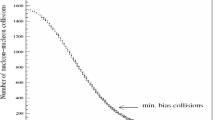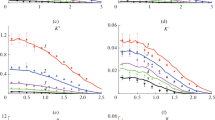Abstract
Four most widely used models of hadronic interactions at high energies implemented in CORSIKA program were compared basing on the simulation of the first nucleus–nucleus interactions of cosmic rays with the atmosphere. For this comparison the distributions of the number of produced particles of different types were obtained, as long as the mean values of these numbers. The dependences of the fraction of the collision energy carried by different secondary particles on the mass of the primary particle were calculated for each model. The check of the electric charge conservation law implementation was performed. Comparison shows vast differences between the models in some cases that may result in different interpretation of experimental data.




Similar content being viewed by others
REFERENCES
D. Heck, J. Knapp, J. N. Capdevielle, G. Schatz, and T. Thouw, CORSIKA: A Monte Carlo Code to Simulate Extensive Air Showers, FZKA 6019 (Forschungszentrum Karlsruhe, 1998).
K. Werner, F.-M. Liu, and T. Pierog, Phys. Rev. C 74, 044902 (2006).
T. Pierog and K. Werner, Nucl. Phys. Proc. Suppl. 196, 102 (2009).
T. Pierog, Iu. Karpenko, J. M. Katzy, E. Yatsenko, and K. Werner, Phys. Rev. C 92, 034906 (2015).
N. N. Kalmykov, S. S. Ostapchenko, and A. I. Pavlov, Nucl. Phys. Proc. Suppl. B 52, 17 (1997).
S. Ostapchenko, Phys. Rev. D 83, 014018 (2011).
S. Ostapchenko, Phys. Rev. D 89, 074009 (2014).
R. S. Fletcher, T. K. Gaisser, P. Lipari, and T. Stanev, Phys. Rev. D 50, 5710 (1994).
J. Engel, T. K. Gaisser, P. Lipari, and T. Stanev, Phys. Rev. D 46, 5013 (1992).
E.-J. Ahn, R. Engel, T. K. Gaisser, P. Lipari, and T. Stanev, Phys. Rev. D 80, 094003 (2009).
F. Riehn, R. Engel, A. Fedynitch, T. K. Gaisser, and T. Stanev, arXiv: 1912.03300 [astro-ph].
S. Roesler, R. Engel and J. Ranft, in Proceedings Monte Carlo 2000 Conference, Lisbon, Portugal, 2000, Ed. by A. Kling et al. (Springer, Berlin, 2001), p. 1003; hep-ph/0012252.
A. Fedynitch and R. Engel, in Proceedings of the 14th International Conference on Nuclear Reaction Mechanisms, Varenna, Italy, 2015, Ed. by F. Cerutti et al. (CERN, Geneva, 2015), p. 291.
Author information
Authors and Affiliations
Corresponding author
Rights and permissions
About this article
Cite this article
Nikolaenko, R.V., Bogdanov, A.G., Kokoulin, R.P. et al. Comparison of Models of Nucleus–Nucleus Interactions Implemented in CORSIKA. Phys. Atom. Nuclei 84, 1011–1016 (2021). https://doi.org/10.1134/S1063778821130226
Received:
Revised:
Accepted:
Published:
Issue Date:
DOI: https://doi.org/10.1134/S1063778821130226




